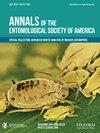Geographic Information System (GIS)-Based Mapping and Spatial Analyses Applied to Risk Assessment and Resource Allocation for Boll Weevil (Coleoptera: Curculionidae) Detection
IF 3
3区 农林科学
Q1 ENTOMOLOGY
引用次数: 2
Abstract
Abstract Boll weevil, Anthonomous grandis grandis Boheman first invaded U.S. cotton in Texas in the late 1800s, and spread throughout U.S. cotton-growing regions by the 1920s. Boll weevil eradication efforts initiated in the eastern United States in the 1980s resulted in its elimination except in the southernmost region of Texas and adjoining areas of Mexico. We focused on geographic information system (GIS)-based mapping and spatial analyses of boll weevil trap data to consider whether landscape features were associated with spatially variable detections of boll weevils. Seven years of trap data were overlaid with data layers of vector-based classifications of cropland, transportation, and hydrological features. New boll weevil detections in 2018 were 108 km north of cotton fields in the Lower Rio Grande Valley (LRGV) where more persistent detections occurred. Focusing on LRGV data, 14 of 24 correlations of number of boll weevil captures to nearest distances to selected landscape features were negative. In follow-up analyses, best data fit was seen using stepwise regression. In 2010, waterbodies and watermelon fields were influential linear terms (partial R2 = 0.14 and 0.064, respectively; model R2 = 0.32). In 2014, the Rio Grande River as a linear term was influential (partial R2 = 0.15; model R2 = 0.24). Boll weevil captures tended to increase in closer proximity to these landscape features. Results of 2010 were consistent with expectations of remnant populations in the LRGV spreading locally, while 2014 results may reflect remnant populations or re-introductions from boll weevil moving longer distances into the LRGV.基于地理信息系统(GIS)的测绘和空间分析在宝铃象甲(鞘翅目:弯甲科)检测风险评估和资源分配中的应用
棉铃象鼻虫(bolonomous grandis grandis Boheman)于19世纪末首次入侵美国德克萨斯州的棉花,并于20世纪20年代在美国棉花种植区蔓延。20世纪80年代在美国东部开始的棉铃象鼻虫根除工作导致除德克萨斯州最南部地区和墨西哥邻近地区外的棉铃象鼻虫被消灭。研究人员利用地理信息系统(GIS)对棉铃象鼻虫诱捕器数据进行制图和空间分析,探讨景观特征是否与棉铃象鼻虫的空间变异检测相关。将7年的捕集器数据与基于向量的农田、交通和水文特征分类数据层叠加。2018年新发现的棉铃象鼻虫发生在Lower里约热内卢Grande Valley (LRGV)棉田以北108公里处,那里发生了更持久的检测。在LRGV数据中,棉铃象鼻虫捕获数与所选景观特征最近距离的24个相关性中有14个呈负相关。在后续分析中,使用逐步回归可以看到最佳的数据拟合。2010年,水体和西瓜田是影响因子线性项(偏R2分别= 0.14和0.064;模型R2 = 0.32)。2014年,里约热内卢格兰德河作为线性项具有影响(偏R2 = 0.15;模型R2 = 0.24)。棉铃象鼻虫的捕获倾向于在靠近这些景观特征的地方增加。2010年的结果与残留种群在LRGV局部传播的预期一致,而2014年的结果可能反映了残留种群或棉铃象鼻虫重新引入LRGV的距离更远。
本文章由计算机程序翻译,如有差异,请以英文原文为准。
求助全文
约1分钟内获得全文
求助全文
来源期刊
CiteScore
4.90
自引率
0.00%
发文量
25
审稿时长
6-12 weeks
期刊介绍:
The Annals of the Entomological Society of America exists to stimulate interdisciplinary dialogue across the entomological disciplines and to advance cooperative interaction among diverse groups of entomologists. It seeks to attract and publish cutting-edge research, reviews, collections of articles on a common topic of broad interest, and discussion of topics with national or international importance. We especially welcome articles covering developing areas of research, controversial issues or debate, and topics of importance to society. Manuscripts that are primarily reports of new species, methodology, pest management, or the biology of single species generally will be referred to other journals of the ESA. The most important criteria for acceptance are quality of work and breadth of interest to the readership.

 求助内容:
求助内容: 应助结果提醒方式:
应助结果提醒方式:


